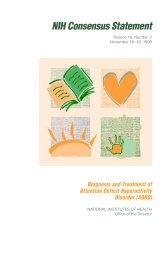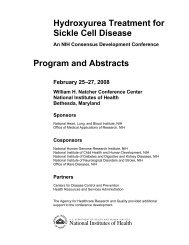Celiac Disease - NIH Consensus Development Program - National ...
Celiac Disease - NIH Consensus Development Program - National ...
Celiac Disease - NIH Consensus Development Program - National ...
You also want an ePaper? Increase the reach of your titles
YUMPU automatically turns print PDFs into web optimized ePapers that Google loves.
ConclusionsIn the clinical setting, serological screening of children for CD is highly accurate.Currently, there is no evidence to support screening all children for CD. Screening of at-riskchildren looks attractive but needs further study. Standardization of screening tests, assessmentof appropriate cutoffs for screening, and algorithms for the evaluation of cases identified onscreening are needed.Areas for Further Study(1) Clarify the natural history of CD and TG seropositivity (to assess the benefit of earlyor preventive treatment) in general, and on type 1 diabetes outcome specifically. (2) Standardizedefinitions and algorithms for evaluation of screening-identified CD. (3) Identify methods topredict progression to frank disease; possible factors include gene dosage, diet, modifier genes,environmental factors, TG quantitation, etc. (5) Analyze the cost/benefit/harm in screening, theoptimal age to begin screening, and frequency of repeat screening. (6) Standardize methods forscreening (tests, cutoffs) children.References1. Frankenburg WK. Selection of diseases and tests in pediatric screening. Pediatrics.1974;54:612–616.2. Wilson JM, Jungner YG. Principles and practice of mass screening for disease. Bol OficinaSanit Panam. 1968;65:281–393.3. Hoffenberg EJ, MacKenzie T, Barriga KJ, et al. A prospective study of the incidence ofchildhood celiac disease. J Pediatr. 2003;143:308–314.4. Fasano A, Berti I, Gerarduzzi T, et al. Prevalence of celiac disease in at-risk and not-at-riskgroups in the United States: A large multicenter study. Arch Intern Med. 2003;163:286–292.5. Revised criteria for diagnosis of coeliac disease. Report of Working Group of EuropeanSociety of Paediatric Gastroenterology and Nutrition. Arch Dis Child. 1990;65:909–911.6. Hill ID, Dirks M, Liptak G, et al. Guideline for the diagnosis and treatment of celiac diseasein children: recommendations of the North American Society for Pediatric Gastroenterology,Hepatology, and Nutrition. J Pediatr Gastroenterol Nutr. 2004;in press.7. Hoffenberg EJ, Bao F, Eisenbarth GS, et al. Transglutaminase antibodies in children with agenetic risk for celiac disease. J Pediatr. 2000;137:356–60.8. Maki M, Mustalahti K, Kokkonen J, et al. Prevalence of <strong>Celiac</strong> disease among children inFinland. N Engl J Med. 2003;348:2517–2524.9. Liu E, Bao F, Barriga K, et al. Fluctuating transglutaminase autoantibodies are related tohistologic features of celiac disease. Clin Gastroenterol Hepatol. 2003;1:356–362.81







